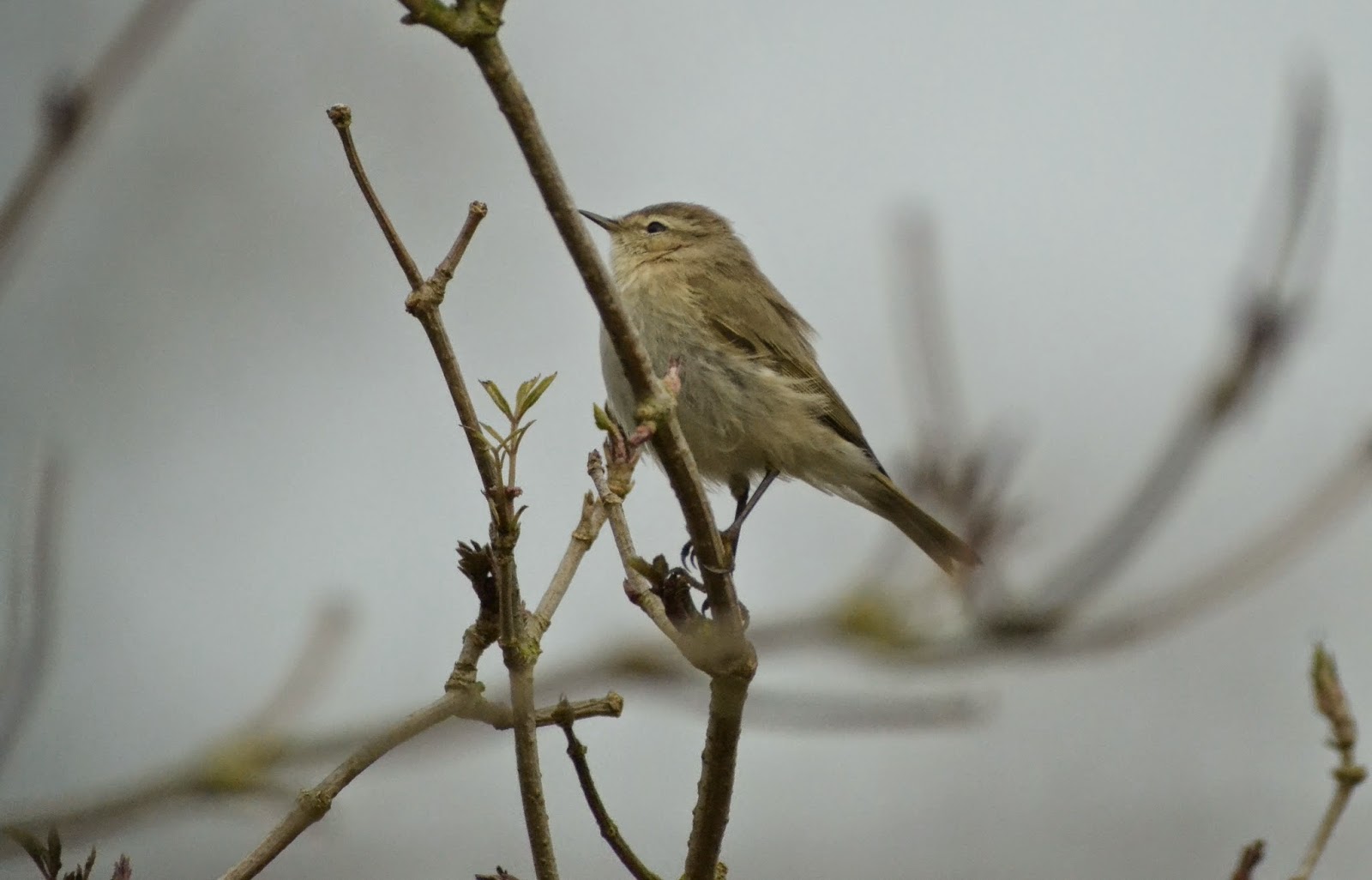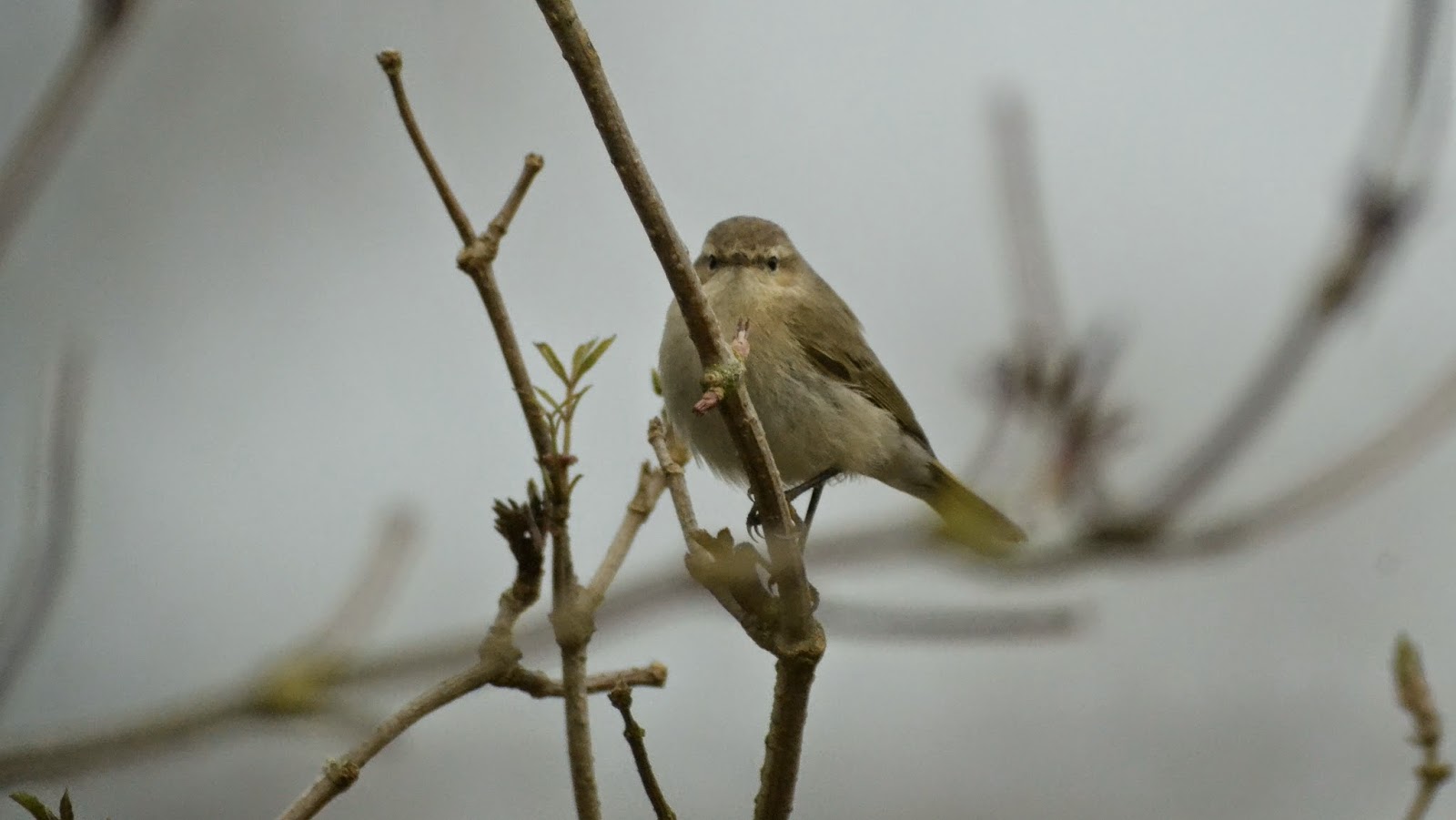Last night I leafed through all the available literature on Siberian chiffchaff in order to be more prepared this morning. I wanted to get a close up of the bird Duncan had found yesterday, so at about 8am I strolled over to the sewage works, camera and scope at the ready. There was a lorry in the gateway on the sainsbury's side and some human activity, and i rightly deduced that any birds would be pushed over to the railway side. As I reached the end of the tall conifer strip a pale phyllosc immediately drew my attention. Before i could react, it flew from the bushy fenceline, over the railway and into a willow just the other side. I quickly walked under the bridge and soon found myself just a few metres from a delightfully showy chiffchaff that displayed all the physical features that i have been led to expect from a Tristis. It didn't call, but i was happy with the pale raw umber upperparts, the buffy white supercilium and underparts, black bill and legs , and the overall lack of yellow. Being a dull morning, I had to shoot at a fairly slow speed, but at least, I thought, I was seeing the bird in neutral conditions.


Before long, the chiffer flew back to the sewage farm and hopped among the shrubbery while I chatted to a bloke who had come to see the bird too. then came a surprise. Another chiffchaff flew into the same bush, and the two birds chased each other briefly before settling down. I looked at both in turn- and couldn't separate them. Certainly not on the brief views I had of the second bird, in dull conditions, looking through branches and against the sky. Both birds seemed to share the same bold pale supercilium and grey-brown and buffy-white bodies. This can't be right surely? Both birds disappeared, and eager to look at what photos I had taken, I made my way back to the van. On the way back I saw another Chiffchaff, one that was singing, and I took the opportunity to compare this obvious collybita with what I had already seen. This bird was darker, dull olive on top and a warmer ochreish underneath, and it's supercilium barely stood out at all. The two birds I had just left were clearly different from this one, and I have to conclude that they were both tristis.
But this is where things get a little frustrating. Yesterday, having had the call from Dunc, I rushed over, completely failed to notice Dunc hidden in the bushes, stood exactly where I was this morning, saw an interesting chiff in the bushes and got a few photos of it before it flew off towards the centre of the sewage farm. As I walked back, Dunc stepped out of the trees and I showed him one of the pics I had just taken. "that's not the bird I've been looking at" came the reply. Dunc had to go unfortunately, but I stood where he had been and after a few minutes a chiffchaff appeared that really stood out. At about 40 metres away, and against the bright if slightly diffuse sunshine, this bird showed exactly why Dunc had noticed it. I struggled to get decent pictures of it due to the distance, but you can see how different it looked compared to a normal collybita........


But, I had a nagging doubt-cloud at the back of my mind. The bird I had seen first was in bright light. My first thought upon seeing it was that it looked different to the average collybita- but when I watched from Dunc's position- this bird was properly different. Colder, whiter, sore-thumbish. But light can do tricky things, especially to subtly plumaged birds, and I started wondering if in fact I had luckily caught the bird after all. This image below is what I showed Dunc.

And this next one is an admittedly poor shot taken in this morning's gloom at the same location, give or take a few feet. This bird is the same bird that appears at the top of this piece. The question is, has the sun brought out the yellowish tinge that is invisible in dull light, or has the camera been affected by the sun and resolved a yellow tone that doesn't actually exist. Are they the same bird at all, or is the bright image from yesterday actually today's second bird.I was alerted to the presence of yesterday's bird by tentative singing. At the time I thought it's unstructured phrasing was down to "early season lack of practice"- but having now listened to tristis singing on Xeno canto- could it have been tristis song? I didn't hear it call at all, which was frustrating- but then again, classic tristis are supposed to be pretty quiet anyway so is this a good thing?
.jpg)
.jpg)
.jpg)
.jpg)
.jpg)
.jpg)
.jpg)
.jpg)
.jpg)
.jpg)
.jpg)
.jpg)
.jpg)
.jpg)

.jpg)



.jpg)
.jpg)
.jpg)
.jpg)
.jpg)